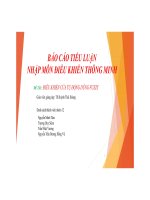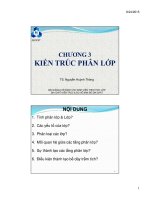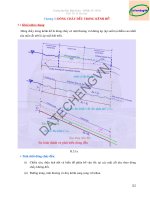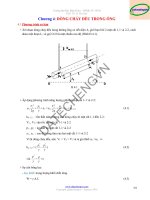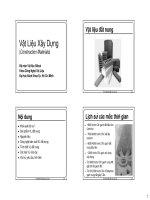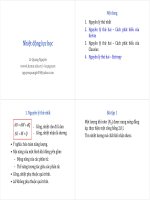Giáo trình bài tập statistics 2
Bạn đang xem bản rút gọn của tài liệu. Xem và tải ngay bản đầy đủ của tài liệu tại đây (794.96 KB, 37 trang )
STATISTICS
DATA DESCRIPTION
Vuong Ba Thinh
1
Statistics
ACKNOWLEDMENT
This slides are composed using the book:
[1] Allan G. Bluman , Elementary Statistics: A Step by
Step Approach, eighth edition 2012.
2
Statistics
OUTLINE
Introduction
Measures of Central Tendency
Measures of Variation
Measures of Position
Exploratory Data Analysis
Q&A
3
Statistics
Introduction
The average American man is five feet, nine inches tall; the average
woman is five feet, 3.6 inches.
The average American is sick in bed seven days a year missing five
days of work.
On the average day, 24 million people receive animal bites.
By his or her 70th birthday, the average American will have eaten 14
steers, 1050 chickens, 3.5 lambs, and 25.2 hogs.
Measures of central tendency, measures of variation, and
measures of position.
4
Statistics
Measures of Central Tendency
A statistic is a characteristic or measure obtained by using
the data values from a sample.
A parameter is a characteristic or measure obtained by
using all the data values from a specific population.
5
Statistics
The Mean
The mean is the sum of the values, divided by the total
number of values. The symbol 𝑋 represents the sample mean.
For a population, the Greek letter 𝜇 (mu) is used for the
mean.
6
Statistics
The Mean (1)
Ex1: The data represent the number of days off per year for a
sample of individuals selected from nine different countries.
Find the mean.
20, 26, 40, 36, 23, 42, 35, 24, 30
Ex2: Miles Run per Week
7
Statistics
The Median
The median is the midpoint of the data array. The symbol
for the median is MD.
Ex1: The number of rooms in the seven hotels in downtown
Pittsburgh is 713, 300, 618, 595, 311, 401, and 292. Find the
median.
Ex2: Find the median for the daily vehicle pass charge for five
U.S. National Parks. The costs are $25, $15, $15, $20, and
$15.
Ex3: Six customers purchased these numbers of magazines:
1, 7, 3, 2, 3, 4. Find the median.
8
Statistics
The Mode
The value that occurs most often in a data set is called the
mode.
Ex1: Find the mode of the signing bonuses of eight NFL
players for a specific year. The bonuses in millions of dollars
are
18.0, 14.0, 34.5, 10, 11.3, 10, 12.4, 10
Ex2: Find the mode for the number of branches that six
banks have.
401, 344, 209, 201, 227, 353
9
Statistics
The Mode (2)
Ex3: The data show the number of licensed nuclear reactors
in the United States for a recent 15-year period. Find the
mode.
104 104 104 104 104
107 109 109 109 110
109 111 112 111 109
Ex4: Miles Run per Week
10
Statistics
Outliers
An outlier is an extremely high or an extremely low data
value when compared with the rest of the data values.
Ex: Salaries of Personnel: A small company consists of the
owner, the manager, the salesperson, and two technicians, all
of whose annual salaries are listed here. (Assume that this is
the entire population.)
Find the mean, median, and mode.
11
Statistics
The Weighted Mean
Ex: Grade Point Average
12
Statistics
Distribution Shapes
13
Statistics
Applying the Concepts
Teacher Salaries
The following data represent salaries (in dollars) from a
school district in Greenwood, South Carolina.
10,000
11,000
11,000
12,500
14,300
17,500
18,000
16,600
19,200
21,560
16,400
107,000
1. First, assume you work for the school board in Greenwood
and do not wish to raise taxes to increase salaries. Compute the
mean, median, and mode, and decide which one would best
support your position to not raise salaries.
14
Statistics
Applying the Concepts (1)
2. Second, assume you work for the teachers’ union and want a
raise for the teachers. Use the best measure of central tendency
to support your position.
3. Explain how outliers can be used to support one or the other
position.
4. If the salaries represented every teacher in the school
district, would the averages be parameters or statistics?
5. Which measure of central tendency can be misleading when
a data set contains outliers?
6. When you are comparing the measures of central tendency,
does the distribution display any skewness? Explain.
15
Statistics
Measures of Variation
Ex: Comparison of Outdoor Paint
16
Statistics
Measures of Variation (1)
17
Statistics
The Range
The range is the highest value minus the lowest value. The
symbol R is used for the range.
R = highest value - lowest value
Ex: Employee Salaries
18
Statistics
Population Variance
The variance is the average of the squares of the distance
each value is from the mean.
The symbol for the population variance is 𝜎 2 (𝜎 is the Greek
lowercase letter sigma).
The formula
19
Statistics
Population Standard Deviation
The standard deviation is the square root of the variance.
The symbol for the population standard deviation is 𝜎.
The formula
20
Statistics
Sample Variance and Standard Deviation
The formula of Sample Variance
The formula of Sample Standard Deviation
Ex: Find the sample variance and standard deviation for the
amount of European auto sales for a sample of 6 years shown. The
data are in millions of dollars.
11.2, 11.9, 12.0, 12.8, 13.4, 14.3
21
Statistics
Variance and Standard Deviation for
Grouped Data
Reading in book [1].
22
Statistics
Coefficient of Variation
Ex: The mean of the number of sales of cars over a 3-month
period is 87, and the standard deviation is 5. The mean of the
commissions is $5225, and the standard deviation is $773.
Compare the variations of the two.
How???
The coefficient of variation, denoted by CVar, is the
standard deviation divided by the mean. The result is
expressed as a percentage.
23
Statistics
Range Rule of Thumb
A rough estimate of the standard deviation is
𝑠 ≈
𝑟𝑎𝑛𝑔𝑒
4
Ex: data set 5, 8, 8, 9, 10, 12, and 13.
24
Statistics
Chebyshev’s Theorem
The proportion of values from a data set that will fall within k standard
1
, where
𝑘2
deviations of the mean will be at least 1 −
greater than 1 (k is not necessarily an integer).
k is a number
Ex1: The mean price of houses in a certain neighborhood is
$50,000, and the standard deviation is $10,000. Find the price
range for which at least 75% of the houses will sell.
Ex2: A survey of local companies found that the mean amount of
travel allowance for executives was $0.25 per mile. The standard
deviation was $0.02. Using Chebyshev’s theorem, find the
minimum percentage of the data values that will fall between
$0.20 and $0.30.
25
Statistics


